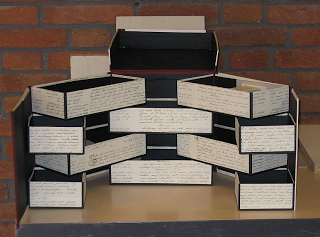I just realised that it's been ages since I last posted something textile-y that is nice and old... so I picked something out at random.
Here you go:

Have you ever seen something like this?
No?
It's a very special textile, but not a proper garment. It seems to be a mix of a burial shroud and a grave garment. You can see the armscyes and a neckopening, and the legs were covered with the leg parts. I'm always reminded a little bit of a baby's romper suit, though the wearer of this expensive, patterned silk lampas certainly didn't romp about anymore, and the piece can have covered only his front.
The piece comes from the grave of
Rudolf IV, died 1365. This object is really one-of-a-kind; we know normal garments worn normally in death (especially when accidents happened in bogs), we have lots of proper garments used as shroud textiles in Herjolfsnæs, and we have special grave garments that are only basted together, but still follow the normal tailoring scheme more or less. There is no parallel that I know of for Rudolf IV's shroud/garment. It's the time of short men's jackets and tight-fitting hose. Maybe that was the reason why they cut into a large piece of perfectly fine lampas for some fake tailoring - to have a quick yet costly-looking and representative burial dress for the corpse. He died in July in Milano, and the corpse was transported to Austria to bury it there, so it's possible to imagine why dressing it in proper garments might not have been possible anymore, which would be another reason for a special solution like this.
Whatever the cause, it still looks splendid, and I can easily imagine that when the cloth was used back in 1365, it was fit for a representative burial. And for us today, it tells a bit more about the possibilities and the ingenious solutions of burial problems in the middle ages - the dead body has to represent status, wealth, position, rank, not only until the grave, but right into it. And this has to be achieved no matter if the dead is already decomposing or not...
Picture source: MARINI, PAOLA, NAPIONE, ETTORE und VARANINI, GIAN MARIA (Hrsg.): Cangrande della Scala. La morte e il corredo di un principe nel medioevo europeo. Venedig 2004, page 127.
Oh, and by the way, this is post number 100 in this blog - so happy hundredpostiversary!






